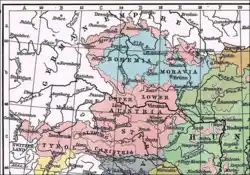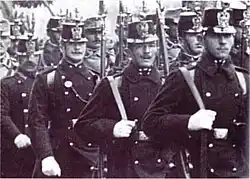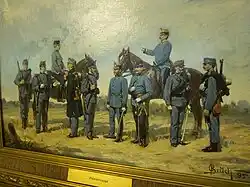Austrian military records document the service of Austrian citizens and the subjects of the multiple ethnicities that lived within Austrian-controlled territory. These records reflect, and provide valuable insights into, the complex and turbulent history of the country over the last few centuries, through war and peace. They also represent the backdrop to the society in which these individuals lived.

At the start of the 19th century Austria was the center of an empire ruled by the Hapsburgs. By the middle of that century it had become half of the expansive Austro-Hungarian Empire, combining with Hungary while retaining its own distinct structures. After the collapse of that empire in 1918 Austria became a separate, but weak republic. It was then subsumed into the German Third Reich as a result of the Nazi Anschluss of 1938. Following the Axis defeat in World War II, Austria was occupied by the Allied powers before emerging in 1955 once again as an independent nation, this time committed to neutrality.
Austria's military has also evolved, from an imperial force which projected national power and prestige, to a essentially defensive role in a nation whose constitution provided it must never again join a military alliance, host foreign military bases within its borders, or participate in a war.
Research your ancestors on MyHeritage
Impact of Austrian military serviceImpact of Austrian military service

Military service touched the lives of almost all Austrian families during the Empires, either directly or indirectly. Throughout this period the lesser ranks of the nobility and members of Austria's upper classes were the source for the general staff and senior military officers. Many men of lower rank were forced into the military, or joined voluntarily for economic reasons. Until the early 19th century military service for ordinary soldiers was a lifetime commitment, although this did not necessarily involve continuous active duty. By the mid-19th century military conscription had become compulsory. However, various professions and trades were deemed essential and were exempt from service. Examples of these exemptions were clergy members and agricultural occupations.[1]
One unusual feature of Austria's military was that, unlike elsewhere in Europe, there was little discrimination of the various ethnic groups, including Jews, that fell under Austria's jurisdiction. Individuals from many ethnicities were represented at all levels of the military, including the officer corps. Similarly, there was generally no segregation in Austria's military structure of adherents to the various religions found within the Empire.[2]
Researching Austrian military recordsResearching Austrian military records
The wiki article How to research military records is a good starting point for family historians interested in exploring ancestors who served in Austria's military forces, or who were otherwise impacted by war. The article provides general guidance on issues such as preparatory steps you can take to make your search for military records more productive as well as pointing to other potential sources of Austrian military records beyond those made available by the more obvious official sources.

As with research for military records in general, it is highly desirable to first assemble whatever information you already have at hand about the individual of interest, such as:
- Full name
- Birth year and birth location, if possible down to the town/village and ethnic region of the Austrian Empire or nation state as it existed at that time
- Service details such as branch of the military in which the individual served, their rank, combat campaigns, and whether the individual was wounded, captured or killed while on duty
There are also considerations specific to Austria that you need to taken into account as you begin your research. An appreciation of Austria's military history is important, especially if searching for information during the time of the Austrian Empire or subsequent Austro-Hungarian Empire. During these periods there was no concept in the modern sense of Austrian citizenship. Rather, personnel serving in Austria's military forces were designated according to many different ethnic groups. With the dissolution of the Austrian Empires, military records for these individuals are likely located in the archives of another successor country. These ethnic groups included, but were not limited to:
- Armenian
- Turkish
- Bosnian
- Bulgarian
- Serb
- Croatian
- Dalmatian
- Slavonian
- Slovene
- Slovakian
- Czech
- Moravian
- Jew
- Rusyn
- Hungarian
- Romanian
- Polish
- Ukrainian
- Italian
- German
- and even Gypsy.
Austrian military records are increasingly being digitized and made available for easy online access, including at MyHeritage. Nevertheless these digitized records are still far from complete, especially when it comes to older records. Research involving original paper sources, held in various archives, requires reading documents handwritten in old German, as almost all records will be in this language; remaining sources will be in the various languages of ethnic groups that made up the old empires. This is where the services of a qualified professional genealogist may be useful.
During World War II, Austrian soldiers were incorporated into the German Wehrmacht and fought on various fronts of the war as part of the Axis forces. Therefore, researching Austrian military records from this period may best be approached the same as researching German military records.
Most of the records kept in the Austrian State Archives, including military records, are accessible to the public. However, Austrian privacy protection law requires that waiting periods apply. These vary from 30 to 50 years, calculated based on the date of the original record. In special circumstances, or for approved professional research, the waiting period can be reduced.
Where to find Austrian military recordsWhere to find Austrian military records

Austrian State Archives (Kriegsarchiv) in Vienna contains documents relating to the Austrian military, dating from the 16th century through the end of World War II, housed in their War Archives. The records comprise both documents of the military administration and commands, and personnel records. Indexes to many of the records are available, especially if the individual you are researching was an officer, staff member, or military official. In addition to indexes of soldier's names, indexes of regiments and recruitment places are typically available. Enlisted men can be located when the name of the regiment, or military unit, or place of recruitment is known. If not known, the first step is to refer to regimental or recruitment location indexes.
The other main official sources of Austrian military records are part of a broader range of documents held by various city archives, especially the Vienna City Archives (Stadt Wien). Local archives in Salzburg, Tyrol, and Vorarlberg hold limited service information and recruitment records for soldiers from these provinces, covering the period of the Austro-Hungarian Army. They also hold some information on soldiers who served in the German Wehrmacht during the period of Anschluss.
Older military records, or those involving individuals from specific ethnic groups who served within the empires, may also be found in other countries which emerged after their dissolution. These include the archives of:
For example, the old Austro-Hungarian Empire encompassed Galicia, a historical and geographic region spanning what is now southeastern Poland and western Ukraine. Microfilms of original military manuscripts from the period of the Empire are held at the Central State Historical Archives of Ukraine in L′viv. Other military records covering the Galicia region are now held in Polish archives. Some of these records, from 1781 to 1865, still survive and are available online.[3]
Tens of thousands of Austrian military personnel were captured during World War II, most ending up in United States or Russian prisoner of war (POW) camps. Information about individual POWs while in captivity is stored in the respective countries national archives, although gaining access is likely to be time-consuming and the results uncertain.
What can be found in Austrian military recordsWhat can be found in Austrian military records
Austrian State Archives (Kriegsarchiv) personnel records include muster rolls, registration sheets, casualty lists of World War I, and lists of POWs of World War I. Some specialist databases are also available covering topics such as:
- War graves documents
- Wartime decorations
- Court martial files
- Certificates of Non-Commissioned Officers (NCOs)
- Conduct evaluations and personnel records
- Personal papers of officers
Military records held by city and state archives may contain:
- Names of soldiers and mercenaries, their age, rank, date and place of muster
- Birth registers
- Lists of 17-21 year old males, as well as information on their parents, places of residence and even physical descriptions.
While many records are available online, for those that aren’t microfilm versions can be viewed at the archive reading room. These must be ordered at least 14 days in advance. Fees apply for making copies on a per page basis.[4] Information may also be requested by mail or email, response times can vary widely, from weeks to months.
See alsoSee also
- Austria-Hungary, World War I Casualty Lists, 1914-1918 at MyHeritage
- Jewish Holocaust Memorials and Jewish Residents of Germany at MyHeritage
- Austria Burials, 1768-1918 at MyHeritage
- Austria, Mauthausen Death Book from JewishGen at MyHeritage
- Ask the Expert - Military Records on MyHeritage at MyHeritage Knowledge Base
Explore more about Austrian military recordsExplore more about Austrian military records
- Austria Military Records at FamilySearch
- A Guide for Locating Austro-Hungarian Military Records at Austro-Hungarian Army Records Blog
- Sources for Genealogical Research at the Austrian War Archives in Vienna at Austrian State Archives
References
- ↑ Wiki, C. to M. (n.d.). Military of austria-hungary. Military Wiki.
- ↑ Fritz, J. (2014, August 17). Jewish soldiers in the Austro-Hungarian Army. Der Erste Weltkrieg.
- ↑ Heather, P. An overview of Galician military records between 1781-1865 - Galicia genealogy.
- ↑ How to use the Archives. How to use the archives - Austrian State Archives. (n.d.).

